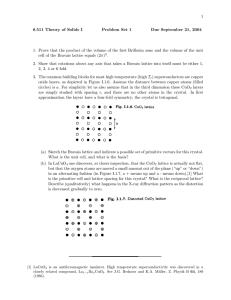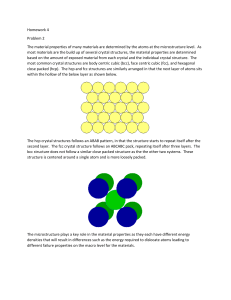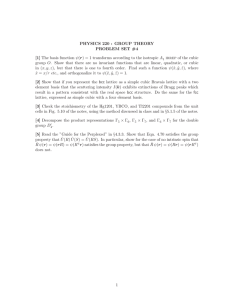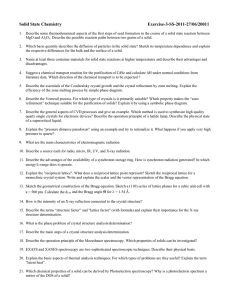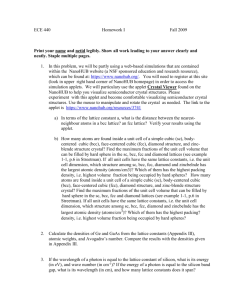Classification of Solid Structures
advertisement
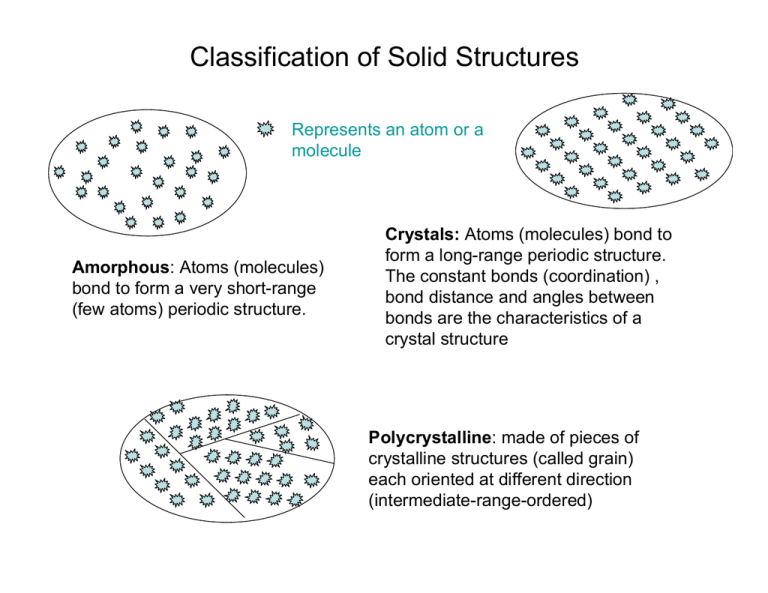
Classification of Solid Structures
Represents an atom or a
molecule
Amorphous: Atoms (molecules)
bond to form a very short-range
(few atoms) periodic structure.
Crystals: Atoms (molecules) bond to
form a long-range periodic structure.
The constant bonds (coordination) ,
bond distance and angles between
bonds are the characteristics of a
crystal structure
Polycrystalline: made of pieces of
crystalline structures (called grain)
each oriented at different direction
(intermediate-range-ordered)
Crystals
An IDEAL CRYSTAL is constructed by the infinite repetition of identical
structural units in space.
Crystalline Structures
(b)
Lattice Structures
• A LATTICE represents a set of points in space that form
a periodic structure. Each point sees exactly the same
environment. The lattice is by itself a mathematical
abstraction.
• A building block of atoms called the BASIS is then
attached to each lattice point yielding the crystal
structure.
• LATTICE + BASIS = CRYSTAL STRUCTURE
• The identical structure units that have small volume are
called UNIT CELL.
Crystal lattices
O'
O
A 2-D lattice showing translation of a unit cell by R = 4a + 2b
Lattice Structure
ODEF is primitive unit cell and PQRS is the conventional unit
cell of the above lattice
Crystals
The smallest unit cell is called PRIMITIVE CELL and the
cell that is most convenient to study crystal structure
is called CONVENTIONAL UNIT CELL.
A unit cell contains all the structural and physical
properties of the crystal.
A unit cell IS NOT a unique entity.
The relationship between unit cell and lattice is characterized by
three vectors, . Every equivalent lattice point in the 3-D crystal
can be found using the vector:
R = pa +qb + sc
,
p, q, s are integers.
Tetragonal I
Tetragonal
P
Orthorhombi
cP
b
Cubic F
Cubic I
Cubic P
Orthorhombi
cC
Monoclinic P
Orthorhombi
cI
Monoclinic C
Orthorhombi
cF
Triclinic
γ
α
β
a
c
Trigonal R
Trigonal and
Hexagonal R
Lattice Structures
Simple Cube
SC
Body Centred Cube
BCC
Lattice Constant
Side diagonal
Body diagonal
a 2
a 3
a
Face Centred Cube
FCC
Examples of SC & BCC
a
Simple cubic (SC): Polonium
(Po)
Body centered cubic (BCC) unit cell:
Alkali metals (Li, Na, K), Cr, Mo, Mn
Ref: S.O. Kasap, Principles of Electronic materials and devices
Example of FCC Structure
(a) The crystal structure of copper
is face centered cubic (FCC).
The atoms are positioned
at well defined sites arranged
periodically and there is a
long range order in the
crystal.
(b) An FCC unit cell with closed
packed spheres.
(c) Reduced sphere representation
of the unit cell. Examples:
Ag, Al, Au, Ca, Cu, Ni.
Number of atoms per unit cell
8 corners = 8 × (1/8)=1
6 faces = 6 × (1/2) = 3
Lattice Structure
• Miller Indices
For any cubic unit cell
system:
- build axes along the edges
of unit cell
- normalize intercepts: 3, 2, 1
- invert intercepts:
1/3, 1/2, 1
- adjust:
2/6, 3/6,
6/6
- Miller Indices: (236)
z
b
y
a
x
Z
Z
y
X
y
X
(110)
(100)
Z
Z
y
y
X
X
(111)
Some popular lattice planes
(200)
Crystals
Parameters that characterize a crystal structure:
•
•
•
•
•
•
•
Lattice structure (e.g. cubic, tetragonal, etc.).
Basis.
Number of atoms in a unit cell.
Crystal planes e.g. {100}, {110}, {111}, Miller Indices.
Number of atoms in each plane.
Chemical binding (e.g. metallic, covalent, …).
Number of nearest (nn) and next nearest (nnn) atoms to
each atom.
Example of (100)
(100)
c
z
x
a
y
b
Example of (110)
z
c
x
a
y
b
Example of (111)
c
z
x
a
y
b
Diamond Structure
•
Top view of an extended (100) plane of the diamond lattice
structure.
z
001
c
011
101
111
z
1 3 3
4 4 4
3 1 3
4 4 4
1
1
0
2
2
y
x
1 1 1
4 4 4
3 3 1
4 4 4
000
b
100
a
x
1
2
1
2
0
110
The unit cell of diamond lattice structure. The position of each
lattice point is shown with respect to the 000 lattice point.
010
y
Si (100) Crystal
c
•
Plane intercepts at x=1
•
Plane contains 2 unit
cells (1+¼+¼+¼+¼)
z
y
x
b
a
a
a
Si (110) Crystal
c
•
Plane intercepts at
x=1, y=1
•
Plane contains 4 unit
cells (2 + 2*½ + 4*¼)
z
y
x
b
a
a√2
a
Si (111) Crystal
c
•
Plane intercepts at
x=1, y=1, z=1
•
Plane contains 2 unit
cells (3*½ + 3*1/6)
z
y
x
b
a
a√2
Two Interpenetrating Face-Centered Cubic Lattices
Silicon – Diamond Structure
Common Planes
• {100} Plane
• {110} Plane
• {111} Plane
a
a – Lattice Constant
For Silicon
a = 5.34 A
o
a
Terms used often to characterize a crystalline structure:
1) Relationship between lattice constant and
radius of the atoms
2) Atomic packing factor (APF) defined as:
APF =
Volume of atoms in unit cell
Volume of unit cell
3) Atomic surface density (# of atoms/unit of area) and volume density
(# of atoms /unit of volume)
4) Distance between nearest neighboring atoms
Example 1.3. Consider a BCC structure.
What are the surface density of atoms for (100), (110) and (111)
planes?
(110)
(111)
(100)
a
a
a
a
√2 a
a
a
a
A=
√2 a
a2
A=
Answers: (100)
1
a
2
(110)
2
2a 2
Practice: You do this for an FCC structure.
1
(111)
3a 2
3a 2
2
Silicon Production
−1800°C
SiC ( solid ) + SiO2 ( solid ) ⎯1600
⎯⎯
⎯
⎯→ Si (liquid ) + SiO ( gas) + CO ( gas )
•
•
•
Produced silicon at this stage is 98% pure and is called Metallurgical
Grade Silicon (MGS).
For electronic purposes very high pure silicon - Electronic Grade
Silicon (EGS) is needed.
To obtain EGS from MGS the following reactions are used:
°C
Si ( solid ) + 3HCl ( gas ) ⎯300
⎯⎯
→ SiHCl3 ( gas ) + H 2 + heat
2 SiHCl3 ( gas ) + 2 H 2 ( gas ) → 2 Si ( solid ) + 6 HCl ( gas )
The above process is called chemical vapour deposition (CVD)
and the produced Si is polycrystalline and 99.999% pure.
Silicon crystal preparation
Single crystal Ingots or boules (bulk):
A large single crystal Ingot grows from melt
polycrystalline Si, using solidification on a seed
crystal. The seed is slowly pulled from the melt. As
the seed is slowly pulled, solidification occurs along
the plane between the solid-liquid interface.
Usually the crystal is also rotated slowly to provide
a slight stirring action to the melt, resulting a more
uniform temperature.
Rotation
RF
heating
Single crystal: 20-30 cm in diameter and 1-2 m in length.
Silicon wafers production
Flat
Single crystal Si ingot (about 2 m)
Ground edge or flat
(100)
Plane
Cut wafer
[100]
Direction
Silicon Wafer
• Type
– n-type (e.g.,As,P, Bi
doping)
– P-type (B, Ga, In doping)
• Orientation
– {100}, {111},…

